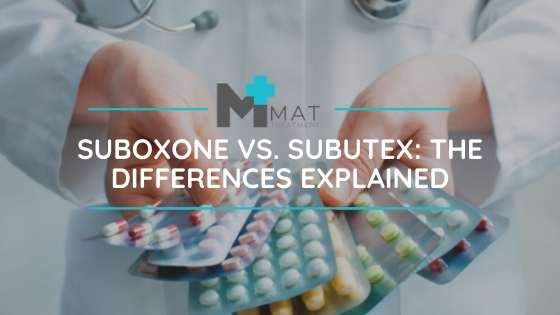Table of Contents
Recent data on the opioid crisis is staggering. It suggests that every day 128 people die of an opioid-related overdose. Numbers like that mean that most of us know someone who is suffering.
When you or someone you care about is going through opioid addiction, you want to make sure to get the best care possible. Thankfully, today there are many effective options for treatment.
This article will explain the difference between Suboxone vs. Subutex. They are similar treatments for opioid addiction recovery. Understanding the differences can be confusing, but we will make it easy so that you can make the best choice for your loved one.
Table of Contents
What is Medication-Assisted Treatment?
Medication-assisted treatment, MAT for short, has proven to be one of the most effective ways to treat substance abuse. You could think of it as using a drug to treat drug addiction. The opioids used via MAT provide a measure of pain relief without the euphoria that can leave users ‘chasing the dragon.’
You may already be familiar with Methadone. It was first on the scene in the 70s to treat opiate abuse and addiction. Paired with rehab and other therapies, it was wildly successful. From there, MAT became the go-to treatment for substance abuse.
Today two additional substances are gaining popularity with MAT. Suboxone and Subutex.
Suboxone and Subutex both contain buprenorphine as the main active ingredient. However, there is a difference between Suboxone and Subutex. We’ll get into that now.
What is Buprenorphine?
Buprenorphine is the active ingredient for both Suboxone and Subutex. It’s a semi-synthetic opiate that is actually derived from the poppy plant. It’s a pain reliever and partial opiate antagonist, so it binds to the same parts of the brain as other pain killers.
The binding is only partial, so the effect has an upper limit. Meaning you won’t get high even if you increase the dose. But you won’t go into withdrawal either.
With the painful symptoms of withdrawal in check, you can function and participate in the recovery process.
Suboxone vs. Subutex
Both of these drugs have been approved by the FDA to treat opioid addiction since early 2000. With Buprenorphine at their core, Subutex and Suboxone are similar treatments. However, there is a difference between Suboxone and Subutex, and you may find one treatment better for you than the other.
Here is a breakdown of the differences.
What is Suboxone Used For?
The active ingredients in Suboxone are Buprenorphine and Naloxone. This is the key distinction between the two and makes it an excellent treatment protocol for opioid withdrawal.
Naloxone is a full opiate antagonist that can actually remove opioids from the brain. Effectively reversing an overdose. Naloxone is also offered as a treatment on its own, most often known as Narcan.
Because of this, Suboxone is less likely to be abused. Its effects are mild, slow to onset, and the opioid blockers mean you can’t take other pain killers while on it.
Suboxone is most commonly used in outpatient treatments as it can be comfortably administered at home. It typically comes in the form of a sublingual strip and is only available with a prescription. It should be noted that Suboxone can make immediate withdrawal symptoms worse and is more appropriate for use before symptoms present.
What is Subutex Used For?
The active ingredient in Subutex is Buprenorphine. There is no opioid blocker, so the potential for abuse is greater. Because of this, Subutex is typically administered in an inpatient facility or detox center, where patients can be monitored and tapered off opiates slowly.
Subutex can be administered sublingually, via a monthly injection, or an implant. Because it has no opioid antagonist, it can be taken safely immediately coming off opiates. It allows for a slow tapering off from opioid dependency, making the discomfort of withdrawal more bearable.
You and your attending physician can determine which protocol will be the best for you, given your unique circumstances.
What Are the Side Effects of Suboxone vs. Subutex?
As with any painkillers, there is the potential for abuse. Because Suboxone has Naloxone in it, abuse is far less likely. As long as the treatments are administered via a prescription or a medical professional, the potential for abuse is diminished.
Commonly reported side-effects include
- Constipation
- Dizziness
- Drowsiness
- Headaches
- Nausea
If you abruptly stop taking either medication, effects can include
- Shivering, shaking, or trembling
- Muscle pain and cramps
- Nausea and vomiting
- Diarrhea
- Runny nose
- Watery eyes
- Hot and cold flashes
In addition, or in response to these symptoms, you may find yourself seeking relief from other sources. It is critical to your treatment success that you work with your doctors. Keep them closely informed of any challenges or changes that arise so they can make adjustments to your treatment protocol.
Which Treatment is Best?
When it comes to Suboxone vs. Subutex, which treatment is better is a personal matter. Both medications work in the same way. They lessen withdrawal effects by satisfying the brain’s craving for opiates.
Both medications provide relief and a road map to long-term recovery by addressing the physical craving and withdrawal symptoms.
Subutex may be better as the initial treatment when symptoms and cravings are at their peak. Once tapered down and out of initial withdrawals, Suboxone may be better indicated.
The choice is highly personal. Working closely with medical professionals will ensure you get the care you need to succeed.
The Road to Recovery
When it comes to recovery, the argument isn’t really Suboxone vs. Subutex, as the treatments are often used in conjunction. The task at hand is determining your specific needs and which medication protocol will best meet them.
Fortunately, today the road to opiate recovery is well-traveled, and there are many success stories. The difference between Suboxone and Subutex is minimal. Both medications are effective in treating substance abuse conditions.
However, they are not a stand-alone treatment. MAT is effective because it pairs well-researched drugs with group support, lifestyle changes, and mental health. Wherever you are at in your recovery, know that you are not alone.
Get Help Today
Don’t go through the process of recovery alone. There are people who can help you with the struggle you’re facing. Get in touch with one today.



